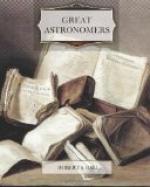this point the difficulties begin. For speculum
metal when cold is excessively brittle, and were the
casting permitted to cool like an ordinary copper
or iron casting, the mirror would inevitably fly into
pieces. Lord Rosse, therefore, found it necessary
to anneal the casting with extreme care by allowing
it to cool very slowly. This was accomplished
by drawing the disc of metal as soon as it had entered
into the solid state, though still glowing red, into
an annealing oven. There the temperature was
allowed to subside so gradually, that six weeks elapsed
before the mirror had reached the temperature of the
external air. The necessity for extreme precaution
in the operation of annealing will be manifest if
we reflect on one of the accidents which happened.
On a certain occasion, after the cooling of a great
casting had been completed, it was found, on withdrawing
the speculum, that it was cracked into two pieces.
This mishap was eventually traced to the fact that
one of the walls of the oven had only a single brick
in its thickness, and that therefore the heat had
escaped more easily through that side than through
the other sides which were built of double thickness.
The speculum had, consequently, not cooled uniformly,
and hence the fracture had resulted. Undeterred,
however, by this failure, as well as by not a few
other difficulties, into a description of which we
cannot now enter, Lord Rosse steadily adhered to his
self-imposed task, and at last succeeded in casting
two perfect discs on which to commence the tedious
processes of grinding and polishing. The magnitude
of the operations involved may perhaps be appreciated
if I mention that the value of the mere copper and
tin entering into the composition of each of the mirrors
was about 500 pounds.
In no part of his undertaking was Lord Rosse’s
mechanical ingenuity more taxed than in the devising
of the mechanism for carrying out the delicate operations
of grinding and polishing the mirrors, whose casting
we have just mentioned. In the ordinary operations
of the telescope-maker, such processes had hitherto
been generally effected by hand, but, of course, such
methods became impossible when dealing with mirrors
which were as large as a good-sized dinner table, and
whose weight was measured by tons. The rough
grinding was effected by means of a tool of cast iron
about the same size as the mirror, which was moved
by suitable machinery both backwards and forwards,
and round and round, plenty of sand and water being
supplied between the mirror and the tool to produce
the necessary attrition. As the process proceeded
and as the surface became smooth, emery was used instead
of sand; and when this stage was complete, the grinding
tool was removed and the polishing tool was substituted.
The essential part of this was a surface of pitch,
which, having been temporarily softened by heat, was
then placed on the mirror, and accepted from the mirror
the proper form. Rouge was then introduced as




